warning FIAT DOBLO COMBI 2015 2.G User Guide
[x] Cancel search | Manufacturer: FIAT, Model Year: 2015, Model line: DOBLO COMBI, Model: FIAT DOBLO COMBI 2015 2.GPages: 323, PDF Size: 46.77 MB
Page 35 of 323
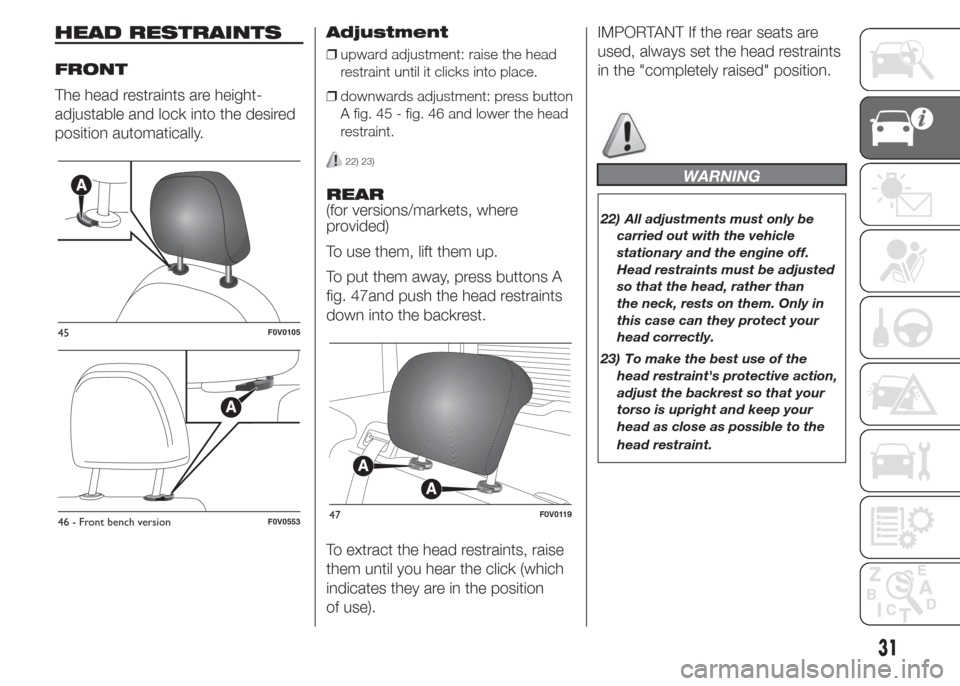
HEAD RESTRAINTS
FRONT
The head restraints are height-
adjustable and lock into the desired
position automatically.Adjustment❒upward adjustment: raise the head
restraint until it clicks into place.
❒downwards adjustment: press button
A fig. 45 - fig. 46 and lower the head
restraint.
22) 23)
REAR
(for versions/markets, where
provided)
To use them, lift them up.
To put them away, press buttons A
fig. 47and push the head restraints
down into the backrest.
To extract the head restraints, raise
them until you hear the click (which
indicates they are in the position
of use).IMPORTANT If the rear seats are
used, always set the head restraints
in the "completely raised" position.
WARNING
22) All adjustments must only be
carried out with the vehicle
stationary and the engine off.
Head restraints must be adjusted
so that the head, rather than
the neck, rests on them. Only in
this case can they protect your
head correctly.
23) To make the best use of the
head restraint's protective action,
adjust the backrest so that your
torso is upright and keep your
head as close as possible to the
head restraint.
45F0V0105
46 - Front bench versionF0V055347F0V0119
31
Page 36 of 323
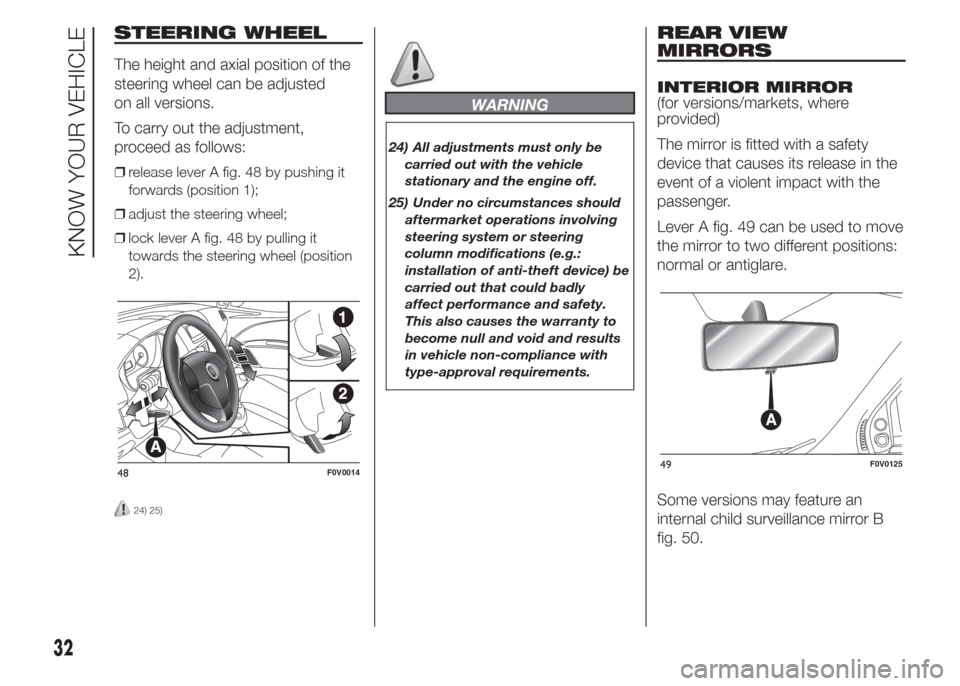
STEERING WHEEL
The height and axial position of the
steering wheel can be adjusted
on all versions.
To carry out the adjustment,
proceed as follows:
❒release lever A fig. 48 by pushing it
forwards (position 1);
❒adjust the steering wheel;
❒lock lever A fig. 48 by pulling it
towards the steering wheel (position
2).
24) 25)
WARNING
24) All adjustments must only be
carried out with the vehicle
stationary and the engine off.
25) Under no circumstances should
aftermarket operations involving
steering system or steering
column modifications (e.g.:
installation of anti-theft device) be
carried out that could badly
affect performance and safety.
This also causes the warranty to
become null and void and results
in vehicle non-compliance with
type-approval requirements.
REAR VIEW
MIRRORS
INTERIOR MIRROR
(for versions/markets, where
provided)
The mirror is fitted with a safety
device that causes its release in the
event of a violent impact with the
passenger.
Lever A fig. 49 can be used to move
the mirror to two different positions:
normal or antiglare.
Some versions may feature an
internal child surveillance mirror B
fig. 50.
48F0V001449F0V0125
32
KNOW YOUR VEHICLE
Page 38 of 323
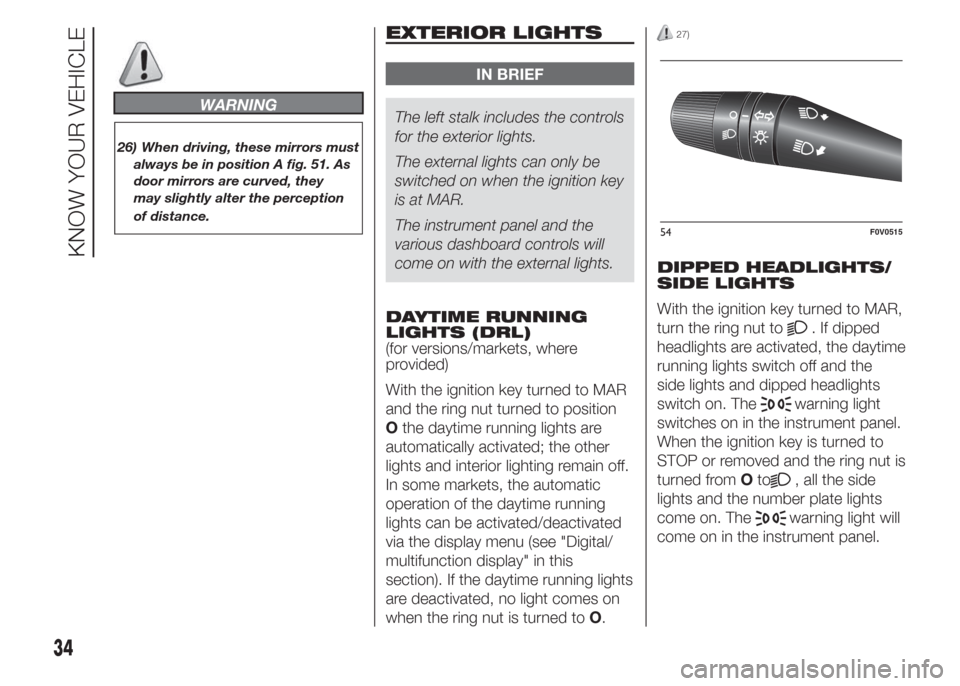
WARNING
26) When driving, these mirrors must
always be in position A fig. 51. As
door mirrors are curved, they
may slightly alter the perception
of distance.
EXTERIOR LIGHTS
IN BRIEF
The left stalk includes the controls
for the exterior lights.
The external lights can only be
switched on when the ignition key
is at MAR.
The instrument panel and the
various dashboard controls will
come on with the external lights.
DAYTIME RUNNING
LIGHTS (DRL)
(for versions/markets, where
provided)
With the ignition key turned to MAR
and the ring nut turned to position
Othe daytime running lights are
automatically activated; the other
lights and interior lighting remain off.
In some markets, the automatic
operation of the daytime running
lights can be activated/deactivated
via the display menu (see "Digital/
multifunction display" in this
section). If the daytime running lights
are deactivated, no light comes on
when the ring nut is turned toO.
27)
DIPPED HEADLIGHTS/
SIDE LIGHTS
With the ignition key turned to MAR,
turn the ring nut to
. If dipped
headlights are activated, the daytime
running lights switch off and the
side lights and dipped headlights
switch on. The
warning light
switches on in the instrument panel.
When the ignition key is turned to
STOP or removed and the ring nut is
turned fromOto
, all the side
lights and the number plate lights
come on. The
warning light will
come on in the instrument panel.
54F0V0515
34
KNOW YOUR VEHICLE
Page 39 of 323
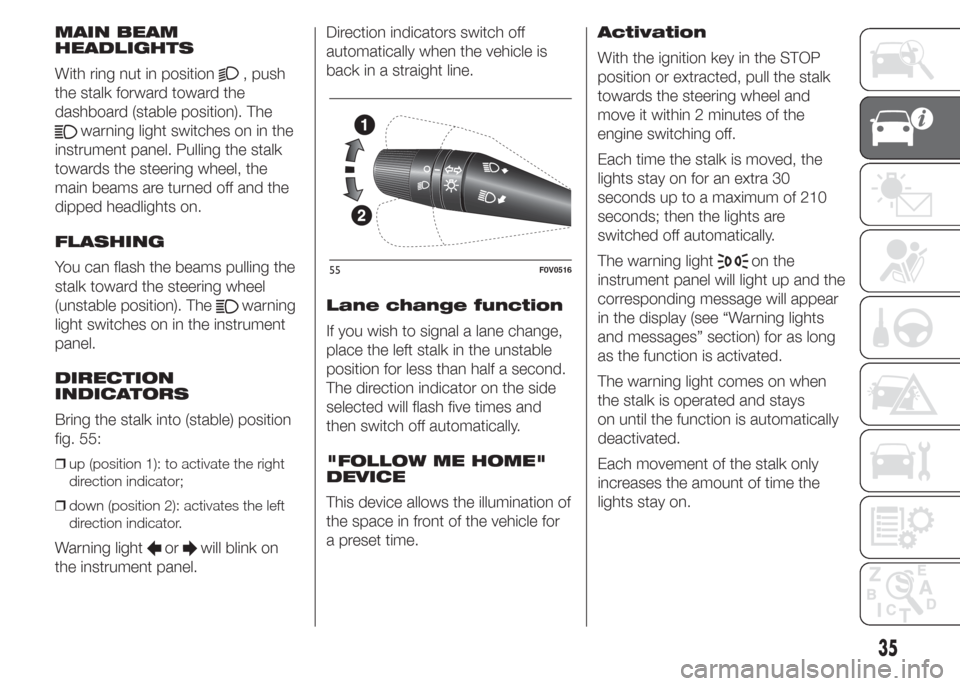
MAIN BEAM
HEADLIGHTS
With ring nut in position
, push
the stalk forward toward the
dashboard (stable position). The
warning light switches on in the
instrument panel. Pulling the stalk
towards the steering wheel, the
main beams are turned off and the
dipped headlights on.
FLASHING
You can flash the beams pulling the
stalk toward the steering wheel
(unstable position). The
warning
light switches on in the instrument
panel.
DIRECTION
INDICATORS
Bring the stalk into (stable) position
fig. 55:
❒up (position 1): to activate the right
direction indicator;
❒down (position 2): activates the left
direction indicator.
Warning lightorwill blink on
the instrument panel.Direction indicators switch off
automatically when the vehicle is
back in a straight line.
Lane change function
If you wish to signal a lane change,
place the left stalk in the unstable
position for less than half a second.
The direction indicator on the side
selected will flash five times and
then switch off automatically.
"FOLLOW ME HOME"
DEVICE
This device allows the illumination of
the space in front of the vehicle for
a preset time.Activation
With the ignition key in the STOP
position or extracted, pull the stalk
towards the steering wheel and
move it within 2 minutes of the
engine switching off.
Each time the stalk is moved, the
lights stay on for an extra 30
seconds up to a maximum of 210
seconds; then the lights are
switched off automatically.
The warning light
on the
instrument panel will light up and the
corresponding message will appear
in the display (see “Warning lights
and messages” section) for as long
as the function is activated.
The warning light comes on when
the stalk is operated and stays
on until the function is automatically
deactivated.
Each movement of the stalk only
increases the amount of time the
lights stay on.55F0V0516
35
Page 40 of 323
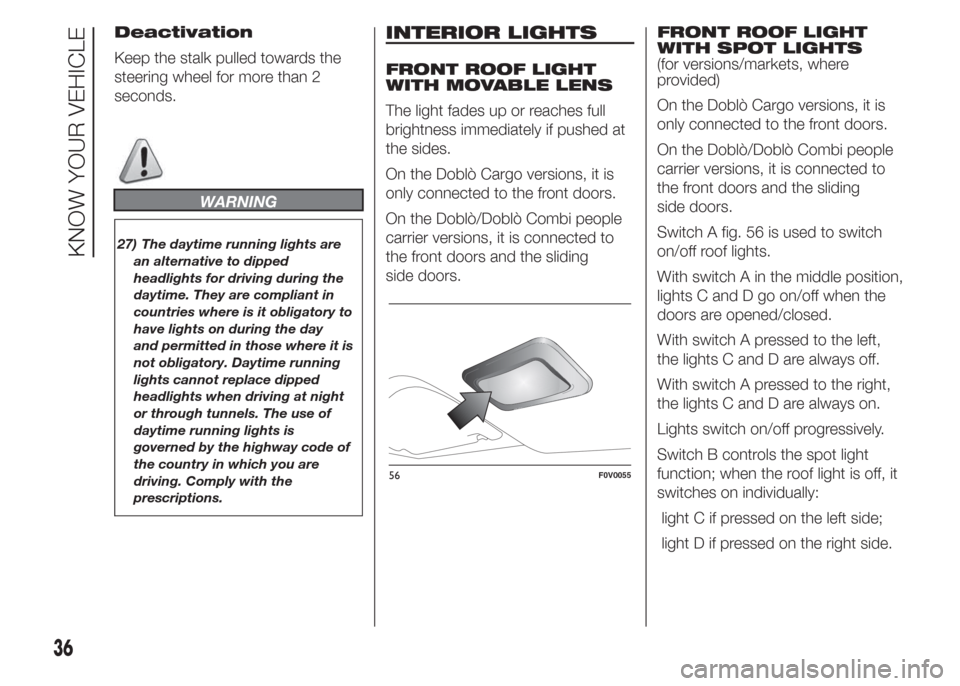
Deactivation
Keep the stalk pulled towards the
steering wheel for more than 2
seconds.
WARNING
27) The daytime running lights are
an alternative to dipped
headlights for driving during the
daytime. They are compliant in
countries where is it obligatory to
have lights on during the day
and permitted in those where it is
not obligatory. Daytime running
lights cannot replace dipped
headlights when driving at night
or through tunnels. The use of
daytime running lights is
governed by the highway code of
the country in which you are
driving. Comply with the
prescriptions.
INTERIOR LIGHTS
FRONT ROOF LIGHT
WITH MOVABLE LENS
The light fades up or reaches full
brightness immediately if pushed at
the sides.
On the Doblò Cargo versions, it is
only connected to the front doors.
On the Doblò/Doblò Combi people
carrier versions, it is connected to
the front doors and the sliding
side doors.FRONT ROOF LIGHT
WITH SPOT LIGHTS
(for versions/markets, where
provided)
On the Doblò Cargo versions, it is
only connected to the front doors.
On the Doblò/Doblò Combi people
carrier versions, it is connected to
the front doors and the sliding
side doors.
Switch A fig. 56 is used to switch
on/off roof lights.
With switch A in the middle position,
lights C and D go on/off when the
doors are opened/closed.
With switch A pressed to the left,
the lights C and D are always off.
With switch A pressed to the right,
the lights C and D are always on.
Lights switch on/off progressively.
Switch B controls the spot light
function; when the roof light is off, it
switches on individually:
light C if pressed on the left side;
light D if pressed on the right side.
56F0V0055
36
KNOW YOUR VEHICLE
Page 62 of 323
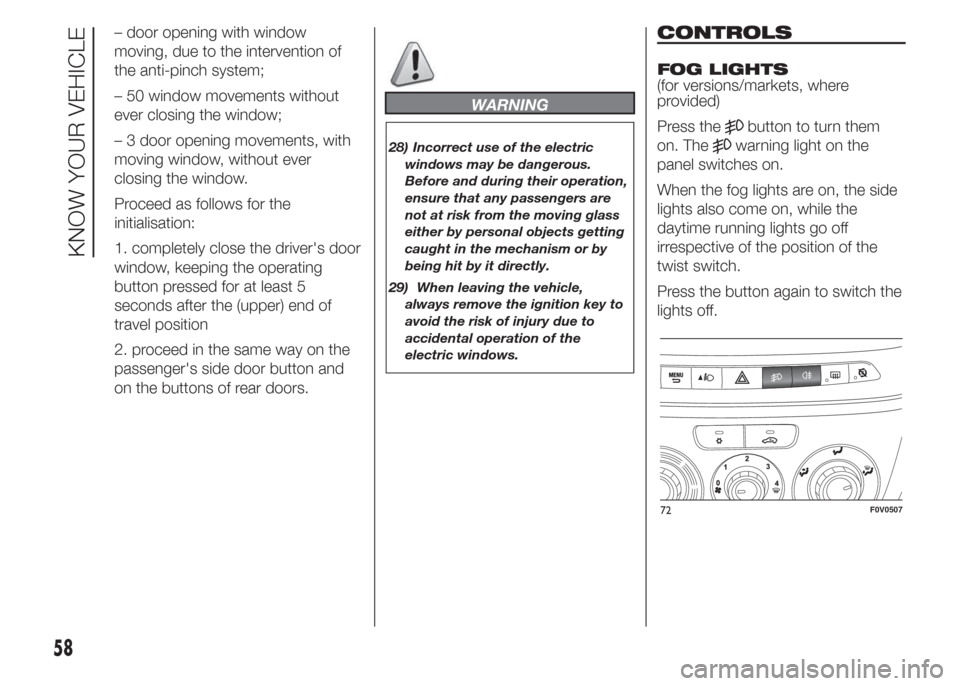
– door opening with window
moving, due to the intervention of
the anti-pinch system;
– 50 window movements without
ever closing the window;
– 3 door opening movements, with
moving window, without ever
closing the window.
Proceed as follows for the
initialisation:
1. completely close the driver's door
window, keeping the operating
button pressed for at least 5
seconds after the (upper) end of
travel position
2. proceed in the same way on the
passenger's side door button and
on the buttons of rear doors.
WARNING
28) Incorrect use of the electric
windows may be dangerous.
Before and during their operation,
ensure that any passengers are
not at risk from the moving glass
either by personal objects getting
caught in the mechanism or by
being hit by it directly.
29) When leaving the vehicle,
always remove the ignition key to
avoid the risk of injury due to
accidental operation of the
electric windows.
CONTROLS
FOG LIGHTS
(for versions/markets, where
provided)
Press the
button to turn them
on. The
warning light on the
panel switches on.
When the fog lights are on, the side
lights also come on, while the
daytime running lights go off
irrespective of the position of the
twist switch.
Press the button again to switch the
lights off.
72F0V0507
58
KNOW YOUR VEHICLE
Page 63 of 323
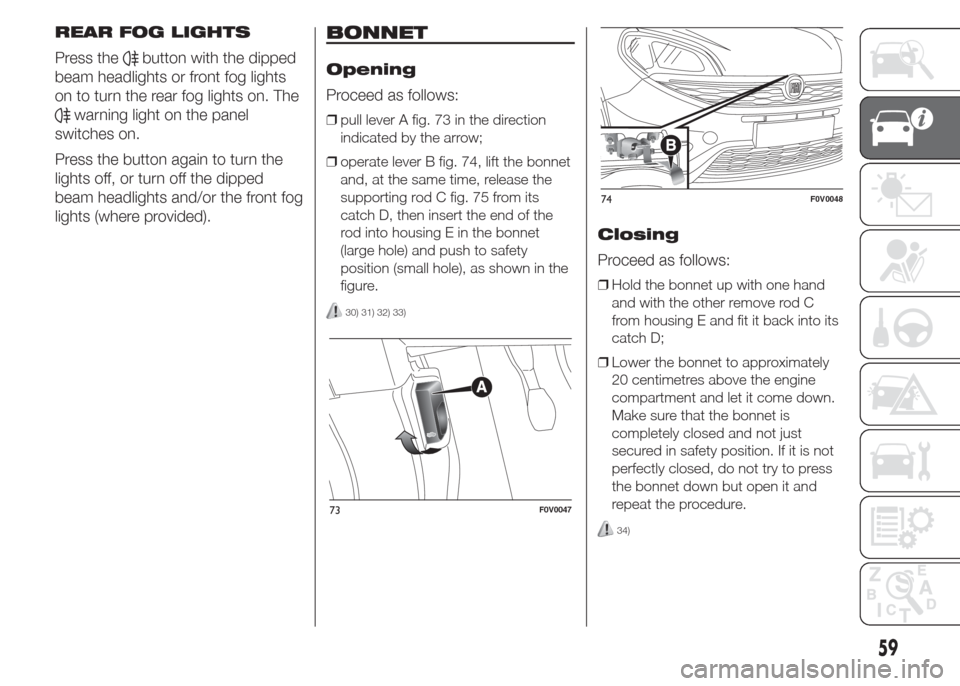
REAR FOG LIGHTS
Press the
button with the dipped
beam headlights or front fog lights
on to turn the rear fog lights on. The
warning light on the panel
switches on.
Press the button again to turn the
lights off, or turn off the dipped
beam headlights and/or the front fog
lights (where provided).
BONNET
Opening
Proceed as follows:
❒pull lever A fig. 73 in the direction
indicated by the arrow;
❒operate lever B fig. 74, lift the bonnet
and, at the same time, release the
supporting rod C fig. 75 from its
catch D, then insert the end of the
rod into housing E in the bonnet
(large hole) and push to safety
position (small hole), as shown in the
figure.
30) 31) 32) 33)
Closing
Proceed as follows:
❒Hold the bonnet up with one hand
and with the other remove rod C
from housing E and fit it back into its
catch D;
❒Lower the bonnet to approximately
20 centimetres above the engine
compartment and let it come down.
Make sure that the bonnet is
completely closed and not just
secured in safety position. If it is not
perfectly closed, do not try to press
the bonnet down but open it and
repeat the procedure.
34)
73F0V0047
74F0V0048
59
Page 64 of 323
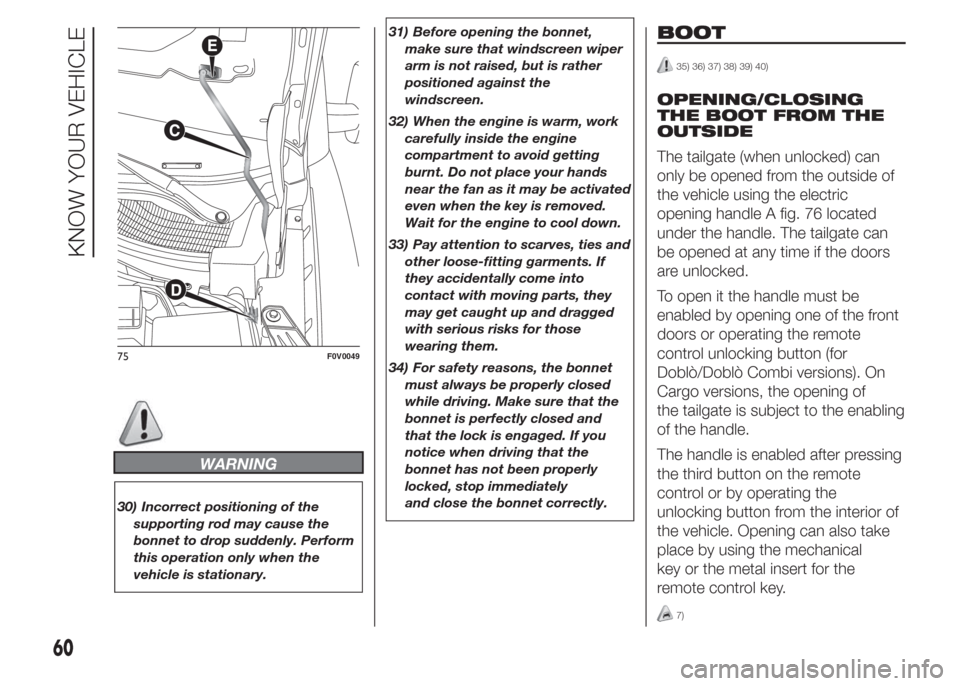
WARNING
30) Incorrect positioning of the
supporting rod may cause the
bonnet to drop suddenly. Perform
this operation only when the
vehicle is stationary.31) Before opening the bonnet,
make sure that windscreen wiper
arm is not raised, but is rather
positioned against the
windscreen.
32) When the engine is warm, work
carefully inside the engine
compartment to avoid getting
burnt. Do not place your hands
near the fan as it may be activated
even when the key is removed.
Wait for the engine to cool down.
33) Pay attention to scarves, ties and
other loose-fitting garments. If
they accidentally come into
contact with moving parts, they
may get caught up and dragged
with serious risks for those
wearing them.
34) For safety reasons, the bonnet
must always be properly closed
while driving. Make sure that the
bonnet is perfectly closed and
that the lock is engaged. If you
notice when driving that the
bonnet has not been properly
locked, stop immediately
and close the bonnet correctly.
BOOT
35) 36) 37) 38) 39) 40)
OPENING/CLOSING
THE BOOT FROM THE
OUTSIDE
The tailgate (when unlocked) can
only be opened from the outside of
the vehicle using the electric
opening handle A fig. 76 located
under the handle. The tailgate can
be opened at any time if the doors
are unlocked.
To open it the handle must be
enabled by opening one of the front
doors or operating the remote
control unlocking button (for
Doblò/Doblò Combi versions). On
Cargo versions, the opening of
the tailgate is subject to the enabling
of the handle.
The handle is enabled after pressing
the third button on the remote
control or by operating the
unlocking button from the interior of
the vehicle. Opening can also take
place by using the mechanical
key or the metal insert for the
remote control key.
7)
75F0V0049
60
KNOW YOUR VEHICLE
Page 67 of 323
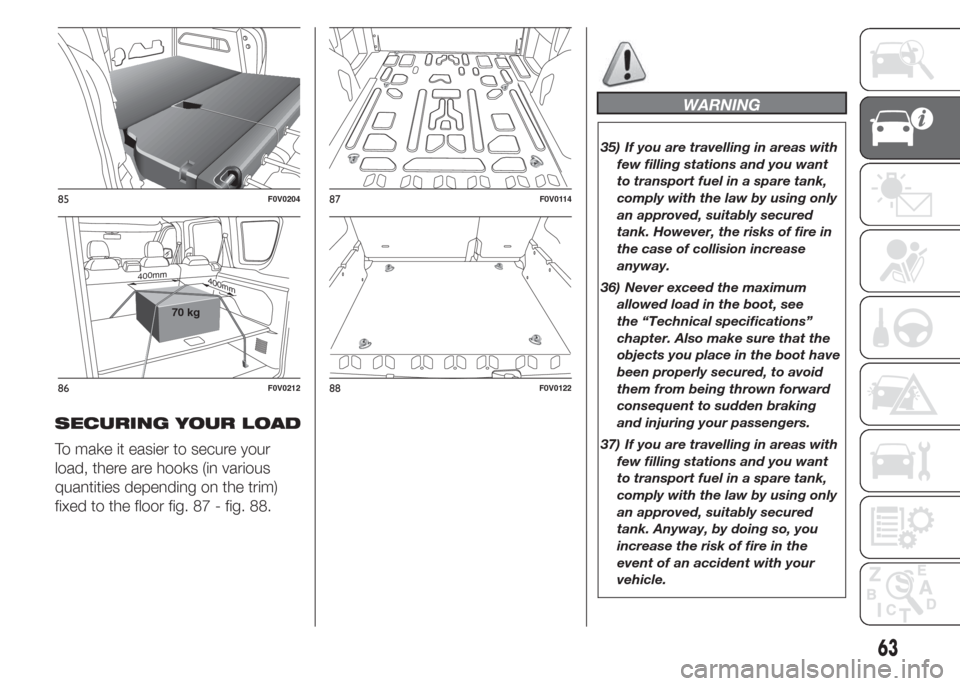
SECURING YOUR LOAD
To make it easier to secure your
load, there are hooks (in various
quantities depending on the trim)
fixed to the floor fig. 87 - fig. 88.
WARNING
35) If you are travelling in areas with
few filling stations and you want
to transport fuel in a spare tank,
comply with the law by using only
an approved, suitably secured
tank. However, the risks of fire in
the case of collision increase
anyway.
36) Never exceed the maximum
allowed load in the boot, see
the “Technical specifications”
chapter. Also make sure that the
objects you place in the boot have
been properly secured, to avoid
them from being thrown forward
consequent to sudden braking
and injuring your passengers.
37) If you are travelling in areas with
few filling stations and you want
to transport fuel in a spare tank,
comply with the law by using only
an approved, suitably secured
tank. Anyway, by doing so, you
increase the risk of fire in the
event of an accident with your
vehicle.
85F0V0204
400mm400mm
70 kg
86F0V0212
87F0V0114
88F0V0122
63
Page 72 of 323
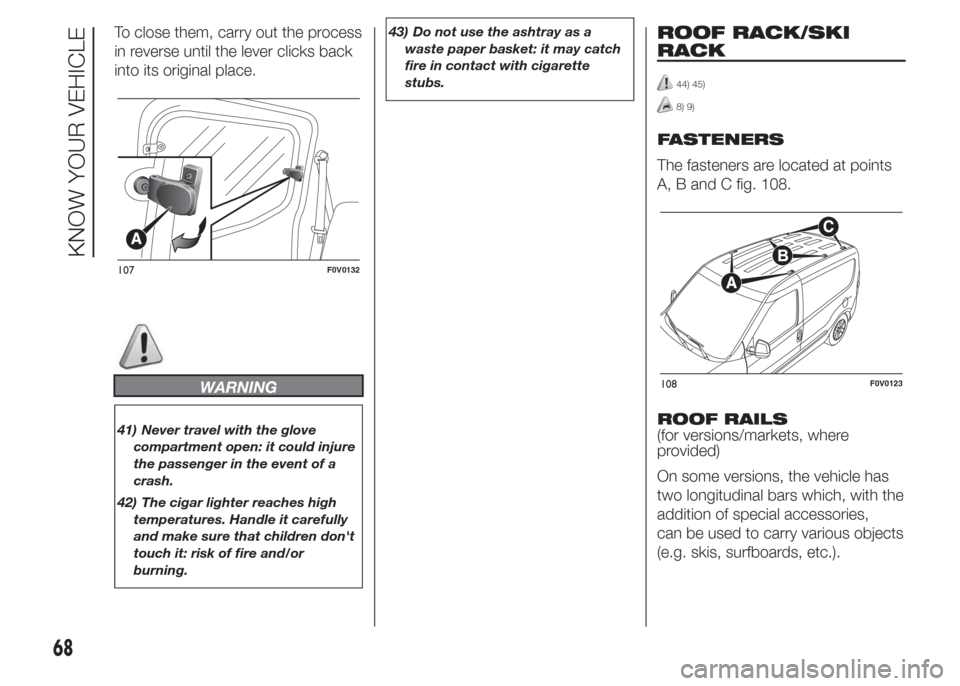
To close them, carry out the process
in reverse until the lever clicks back
into its original place.
WARNING
41) Never travel with the glove
compartment open: it could injure
the passenger in the event of a
crash.
42) The cigar lighter reaches high
temperatures. Handle it carefully
and make sure that children don't
touch it: risk of fire and/or
burning.43) Do not use the ashtray as a
waste paper basket: it may catch
fire in contact with cigarette
stubs.
ROOF RACK/SKI
RACK
44) 45)
8) 9)
FASTENERS
The fasteners are located at points
A, B and C fig. 108.
ROOF RAILS
(for versions/markets, where
provided)
On some versions, the vehicle has
two longitudinal bars which, with the
addition of special accessories,
can be used to carry various objects
(e.g. skis, surfboards, etc.).
107F0V0132
108F0V0123
68
KNOW YOUR VEHICLE